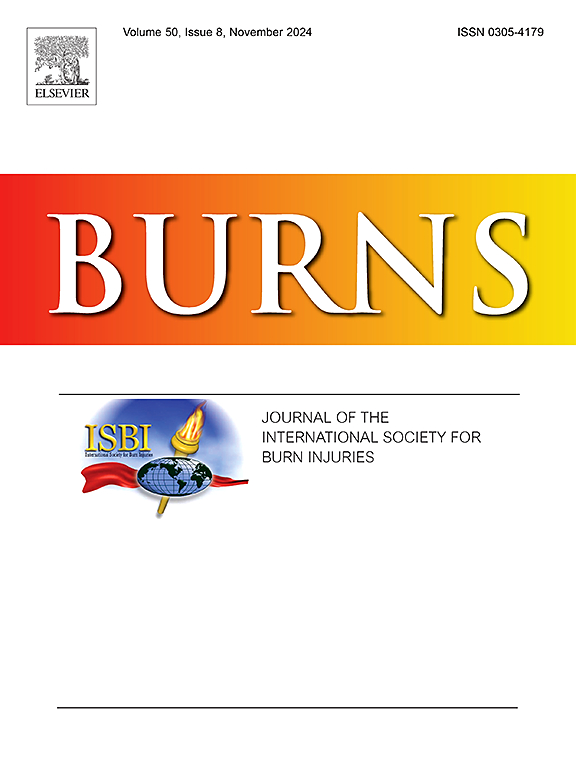The role of anterior segment optical coherence tomography angiography in predicting outcomes of acute ocular burns
IF 2.9
3区 医学
Q2 CRITICAL CARE MEDICINE
引用次数: 0
Abstract
Aim
This study aims to investigate the role of anterior segment optical coherence tomography angiography (AS-OCTA) in determining the prognosis of ocular chemical injuries by correlating angiographic features with early complications and visual outcomes.
Method
Forty-six eyes of 36 patients with acute chemical injuries at Farabi Eye Hospital were studied prospectively. Participants received immediate medical care, followed by thorough ophthalmological examinations, including slit-lamp examination and AS-OCTA imaging. Angiographic parameters were analyzed for both superficial and deep layers of the ocular surface microcirculation in nasal and temporal quadrants.
Results
The study found that increases in deep and superficial vessel diameter indices (VDI) are associated with higher risk of corneal melting and keratitis, respectively, while a decrease in deep VDI is associated with a significantly higher risk of conjunctivalisation. Decreased superficial vessel length density (VLD) and limbal superficial vessel density (VD) are associated with higher risks of corneal opacification. Additionally, limbal ischemia was found to be significantly correlated with longer healing times.
Conclusion
AS-OCTA shows potential as a prognostic tool in ocular chemical injuries. Considering the early changes in angiographic parameters, we can predict specific post-chemical-burn complications.
前段光学相干断层血管造影在预测急性眼部烧伤预后中的作用
目的探讨前段光学相干断层血管造影(AS-OCTA)通过血管造影特征与早期并发症和视力结果的相关性来判断眼化学损伤预后的作用。方法对法拉比眼科医院36例急性化学性损伤患者46只眼进行前瞻性研究。参与者立即接受了医疗护理,随后进行了全面的眼科检查,包括裂隙灯检查和AS-OCTA成像。分析鼻、颞象限眼表微循环的浅、深两层血管造影参数。结果研究发现,深血管直径指数和浅血管直径指数(VDI)的增加分别与角膜融化和角膜炎的高风险相关,而深血管直径指数的降低与结膜炎的风险显著升高相关。浅血管长度密度(VLD)和角膜缘浅血管密度(VD)的降低与角膜混浊的高风险相关。此外,发现边缘缺血与较长的愈合时间显着相关。结论as - octa可作为眼部化学损伤的预后工具。考虑到早期血管造影参数的变化,我们可以预测特定的化学烧伤后并发症。
本文章由计算机程序翻译,如有差异,请以英文原文为准。
求助全文
约1分钟内获得全文
求助全文
来源期刊

Burns
医学-皮肤病学
CiteScore
4.50
自引率
18.50%
发文量
304
审稿时长
72 days
期刊介绍:
Burns aims to foster the exchange of information among all engaged in preventing and treating the effects of burns. The journal focuses on clinical, scientific and social aspects of these injuries and covers the prevention of the injury, the epidemiology of such injuries and all aspects of treatment including development of new techniques and technologies and verification of existing ones. Regular features include clinical and scientific papers, state of the art reviews and descriptions of burn-care in practice.
Topics covered by Burns include: the effects of smoke on man and animals, their tissues and cells; the responses to and treatment of patients and animals with chemical injuries to the skin; the biological and clinical effects of cold injuries; surgical techniques which are, or may be relevant to the treatment of burned patients during the acute or reconstructive phase following injury; well controlled laboratory studies of the effectiveness of anti-microbial agents on infection and new materials on scarring and healing; inflammatory responses to injury, effectiveness of related agents and other compounds used to modify the physiological and cellular responses to the injury; experimental studies of burns and the outcome of burn wound healing; regenerative medicine concerning the skin.
 求助内容:
求助内容: 应助结果提醒方式:
应助结果提醒方式:


